[2]
Gupta V,Somarajan BI,Gupta S,Chaurasia AK,Kumar S,Dutta P,Gupta V,Sharma A,Tayo BO,Nischal K, The inheritance of juvenile onset primary open angle glaucoma. Clinical genetics. 2017 Aug;
[PubMed PMID: 27779752]
[3]
Arora S,Maeda M,Francis B,Maeda M,Sit AJ,Mosaed S,Nazarali S,Damji KF, Efficacy and safety of ab interno trabeculectomy in juvenile open-angle glaucoma. Canadian journal of ophthalmology. Journal canadien d'ophtalmologie. 2018 Oct;
[PubMed PMID: 30340716]
[4]
Svidnicki PV,Braghini CA,Costa VP,Schimiti RB,de Vasconcellos JPC,de Melo MB, Occurrence of MYOC and CYP1B1 variants in juvenile open angle glaucoma Brazilian patients. Ophthalmic genetics. 2018 Dec;
[PubMed PMID: 30484747]
[5]
Kwun Y,Lee EJ,Han JC,Kee C, Clinical Characteristics of Juvenile-onset Open Angle Glaucoma. Korean journal of ophthalmology : KJO. 2016 Apr;
[PubMed PMID: 27051261]
[6]
Gupta V,Gupta S,Dhawan M,Sharma A,Kapoor KS,Sihota R, Extent of asymmetry and unilaterality among juvenile onset primary open angle glaucoma patients. Clinical
[PubMed PMID: 21631667]
[7]
Goldwyn R,Waltman SR,Becker B, Primary open-angle glaucoma in adolescents and young adults. Archives of ophthalmology (Chicago, Ill. : 1960). 1970 Nov;
[PubMed PMID: 5478882]
[8]
Marshall LL,Hayslett RL,Stevens GA, Therapy for Open-Angle Glaucoma. The Consultant pharmacist : the journal of the American Society of Consultant Pharmacists. 2018 Aug 1;
[PubMed PMID: 30068436]
[9]
Wiggs JL,Del Bono EA,Schuman JS,Hutchinson BT,Walton DS, Clinical features of five pedigrees genetically linked to the juvenile glaucoma locus on chromosome 1q21-q31. Ophthalmology. 1995 Dec;
[PubMed PMID: 9098278]
[10]
Alward WL,Fingert JH,Coote MA,Johnson AT,Lerner SF,Junqua D,Durcan FJ,McCartney PJ,Mackey DA,Sheffield VC,Stone EM, Clinical features associated with mutations in the chromosome 1 open-angle glaucoma gene (GLC1A) The New England journal of medicine. 1998 Apr 9;
[PubMed PMID: 9535666]
[11]
Fung DS,Roensch MA,Kooner KS,Cavanagh HD,Whitson JT, Epidemiology and characteristics of childhood glaucoma: results from the Dallas Glaucoma Registry. Clinical ophthalmology (Auckland, N.Z.). 2013;
[PubMed PMID: 24039394]
[12]
Weinreb RN,Leung CK,Crowston JG,Medeiros FA,Friedman DS,Wiggs JL,Martin KR, Primary open-angle glaucoma. Nature reviews. Disease primers. 2016 Sep 22;
[PubMed PMID: 27654570]
[14]
Bradfield YS,Kaminski BM,Repka MX,Melia M,Davitt BV,Johnson DA,Kraker RT,Manny RE,Matta NS,Schloff S,Weise KK, Comparison of Tono-Pen and Goldmann applanation tonometers for measurement of intraocular pressure in healthy children. Journal of AAPOS : the official publication of the American Association for Pediatric Ophthalmology and Strabismus. 2012 Jun;
[PubMed PMID: 22459105]
[15]
Gupta V,James MK,Singh A,Kumar S,Gupta S,Sharma A,Sihota R,Kennedy DJ, Differences in Optic Disc Characteristics of Primary Congenital Glaucoma, Juvenile, and Adult Onset Open Angle Glaucoma Patients. Journal of glaucoma. 2016 Mar;
[PubMed PMID: 25265002]
[16]
Stangos AN,Whatham AR,Sunaric-Megevand G, Primary viscocanalostomy for juvenile open-angle glaucoma. American journal of ophthalmology. 2005 Sep;
[PubMed PMID: 16084786]
[17]
Gupta V,Srivastava RM,Rao A,Mittal M,Fingert J, Clinical correlates to the goniodysgensis among juvenile-onset primary open-angle glaucoma patients. Graefe's archive for clinical and experimental ophthalmology = Albrecht von Graefes Archiv fur klinische und experimentelle Ophthalmologie. 2013 Jun;
[PubMed PMID: 23358655]
[18]
Johnson AT,Drack AV,Kwitek AE,Cannon RL,Stone EM,Alward WL, Clinical features and linkage analysis of a family with autosomal dominant juvenile glaucoma. Ophthalmology. 1993 Apr;
[PubMed PMID: 8479711]
[19]
Talbot AW,Russell-Eggitt I, Pharmaceutical management of the childhood glaucomas. Expert opinion on pharmacotherapy. 2000 May;
[PubMed PMID: 11249511]
Level 3 (low-level) evidence
[20]
Ikeda H,Ishigooka H,Muto T,Tanihara H,Nagata M, Long-term outcome of trabeculotomy for the treatment of developmental glaucoma. Archives of ophthalmology (Chicago, Ill. : 1960). 2004 Aug;
[PubMed PMID: 15302651]
[21]
Gupta V,Ghosh S,Sujeeth M,Chaudhary S,Gupta S,Chaurasia AK,Sihota R,Gupta A,Kapoor KS, Selective laser trabeculoplasty for primary open-angle glaucoma patients younger than 40 years. Canadian journal of ophthalmology. Journal canadien d'ophtalmologie. 2018 Feb;
[PubMed PMID: 29426447]
[22]
Pathania D,Senthil S,Rao HL,Mandal AK,Garudadari CS, Outcomes of trabeculectomy in juvenile open angle glaucoma. Indian journal of ophthalmology. 2014 Feb;
[PubMed PMID: 23571250]
[23]
Tsai JC,Chang HW,Kao CN,Lai IC,Teng MC, Trabeculectomy with mitomycin C versus trabeculectomy alone for juvenile primary open-angle glaucoma. Ophthalmologica. Journal international d'ophtalmologie. International journal of ophthalmology. Zeitschrift fur Augenheilkunde. 2003 Jan-Feb;
[PubMed PMID: 12566869]
[24]
Ishida K,Mandal AK,Netland PA, Glaucoma drainage implants in pediatric patients. Ophthalmology clinics of North America. 2005 Sep;
[PubMed PMID: 16055000]
[25]
Balekudaru S,Vadalkar J,George R,Vijaya L, The use of Ahmed glaucoma valve in the management of pediatric glaucoma. Journal of AAPOS : the official publication of the American Association for Pediatric Ophthalmology and Strabismus. 2014 Aug;
[PubMed PMID: 25173898]
[26]
Ah-Chan JJ,Molteno AC,Bevin TH,Herbison P, Otago Glaucoma Surgery Outcome Study: follow-up of young patients who underwent Molteno implant surgery. Ophthalmology. 2005 Dec;
[PubMed PMID: 16325709]
[27]
Lamoureux EL,Mcintosh R,Constantinou M,Fenwick EK,Xie J,Casson R,Finkelstein E,Goldberg I,Healey P,Thomas R,Ang GS,Pesudovs K,Crowston J, Comparing the effectiveness of selective laser trabeculoplasty with topical medication as initial treatment (the Glaucoma Initial Treatment Study): study protocol for a randomised controlled trial. Trials. 2015 Sep 11;
[PubMed PMID: 26362541]
Level 1 (high-level) evidence
[28]
Koraszewska-Matuszewska B,Samochowiec-Donocik E,Filipek E, [Prognosis in juvenile glaucoma after trabeculectomy]. Klinika oczna. 2002
[PubMed PMID: 12174451]
[29]
Weinreb RN,Aung T,Medeiros FA, The pathophysiology and treatment of glaucoma: a review. JAMA. 2014 May 14;
[PubMed PMID: 24825645]
[30]
Bouhenni RA,Ricker I,Hertle RW, Prevalence and Clinical Characteristics of Childhood Glaucoma at a Tertiary Care Children's Hospital. Journal of glaucoma. 2019 Jul
[PubMed PMID: 30950965]
[31]
Gupta V,Ganesan VL,Kumar S,Chaurasia AK,Malhotra S,Gupta S, Visual Disability Among Juvenile Open-angle Glaucoma Patients. Journal of glaucoma. 2018 Apr
[PubMed PMID: 29394204]


